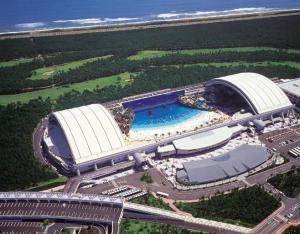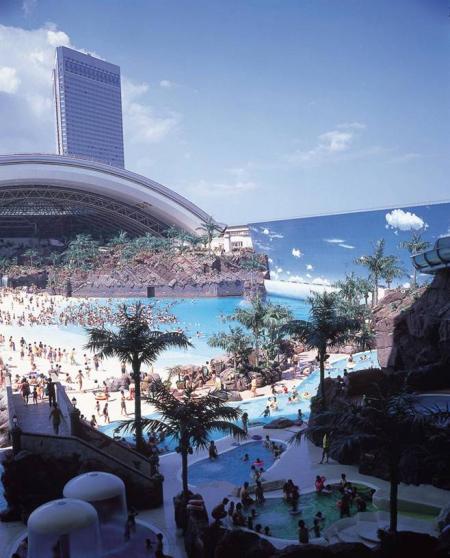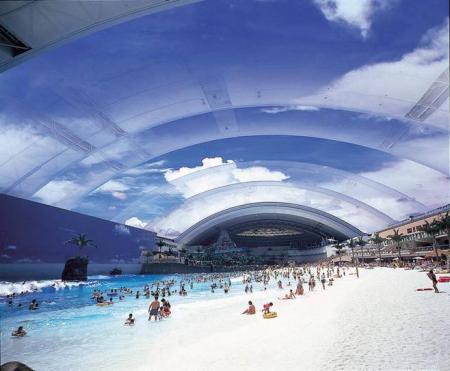Main menu
You are here
The Best Artificial Beach
The Best Artificial Beach

Japan adores to be ahead of the whole world, its people will never get tired of these constant creations and inventions. The Japanese are always making something new, something really interesting and completely addictive.
sun, sand and surf were everyone’s prescription for holiday paradise, but, in the south of Japan, they leave nothing to Mother Nature. Inside a huge dome that could house six football pitches, the world’s largest artificial sea washes over the biggest indoor beach, fringed with fake palm trees and other eye-popping innovations that have given a holiday make-over to old Mother Nature. This time, the Japanese-inventors tossed a challenge to our Mother Nature. Actually, their cool beach is just a huge Ocean Dome (approximately 6 football pitches, it can house 10,000 tourists), that allows everybody to lie on the artificial beach, among artificial palm-trees and enjoy the sound of artificial tide. The real beach is only 300 meters away and it looks really lonely, since if failed to win in this extremely stiff competition.
Ocean Dome is situated on Japan’s southernmost Kyushu Island, 1,500 kilometers south of Tokyo. It has a 85-metre long shoreline and many shops. There are a lot of attractions on this beach:
- the weather is always great, sunny and warm;
- lush green tropical forests without rainfalls and humidity but with parrots songs;
- nice, white beach with crushed marble pebbles without any bugs and sun burns;
- chlorinated salt-free water;
- every 15 minutes the volcano becomes active and every hour it produces fire;
- incredible waves for surfers;
- The fee is rather expensive – more than $50 for adults, plus various entertainment. Many visitors are pleased with such a beach, they considered it to be clean, modern and safe.
- Artificial beaches gain popularity in the whole world. We can see them in Monaco, Hong Kong, Paris etc.

This evocative 21st Century resort shows that even paradise has room for improvement. In Ocean Dome, once every hour, on the hour, the surf is always up. Every afternoon is a carnival. Mechanized parrots squawk from branches of the dome’s ingenious rain forest, which remain lush and tropical without rainfall or humidity.
Instead, perfectly-timed waves whip equally well-groomed surfers along in 28-degree, chlorinated, salt-free water to the sanitized shore where they drip-dry in Ocean Dome’s perfect climate, which remains a delightful 30 degrees, day and night, 365.25 days each year.
Perhaps the best designed beach on the planet sits inside a massive dome measuring 300 by 100 meters, about 1,500 kilometers south of Tokyo in Miyazaki, on Japan’s southernmost Kyushu Island. A heated ocean with a width of 140 meters sends 13,500 tons of salt-free water sweeping across 600 tons of polished marble chips that constitute a 85-metre long shoreline, ringed by a three-story promenade of shops.
Every fifteen minutes, the volcano smokes to life. Every hour, on the hour, it spews fake flames. Like seismic chimes, these pseudo-eruptions sound a “surf’s up” that signals a new level of excitement at this indoor Beach Blanket of the Bizarre.
All of a sudden, the artificial ocean turns tubular, thanks to Ocean Dome’s enormous computer, which commands 10 large vacuum pumps to start sucking in sea, then spitting out a series of cool crests. Teams of professional surfers provide entertainment as they ride 3.5-metre waves, then lifeguards arrange squads of Japanese tourists toting boogie boards on either end of the “sea.” They even point out the perfect points for catching these utterly predictable curls.
After a few minutes of orderly mayhem, the excitement abruptly ends. The staff clear the “ocean” and water jets jutting from the sides of a pair of “islands” squirt powerful spray to tame the rare uproar at this otherwise tranquil indoor sea. Calm quickly returns to the brave new world of Ocean Dome.

This prepackaged holiday vision of the future is part of an enormous US$2 billion recreational complex called Seagaia. The name itself is an odd concoction, melding the English word for the sea with “Gaia,” an ancient Greek word for the Earth. “The name of a true paradise expresses the admiration for the perfect combination of sea and earth,” explains one brochure from Seagaia, which ends: “This is a place where we can feel that we are part of nature.”
Customers pay a single price for admission and all fees are deducted from the computerized bar-coded tag dangling from each guest’s wrist. The tags are color coded according to price, which may be another modern improvement on beach culture of the past. Now, the snobs can instantly separate the have-somes from the have-everythings, without squinting to read bikini labels.
All this indoor beach excitement can be expensive. Admission runs about US$50 for adults, with rides running $5-10 more. Add $10 for two hours with a boogie board, or $5 for two hours of inner tube rental.
Perhaps the oddest thing of all about this artificial environment is its location. Adventurous guests can step outside Ocean Dome and gaze out at… the real beach. From the third floor of the enormous dome, beside rows of eateries like Marco Polo, Buena Vista and Key West, doors lead outside to a balcony and a view of the age-old, unimproved beach, just the way God intended, a mere 300 meters away. It clearly holds little appeal to most visitors.
This is an absolutely amazing beach filled with white sand, blue water, and a lapping wave. But this beach did not exist before 1993. It’s the most popular artificial beach in an arena that’s quickly becoming fashionable. There are now artificial beaches in Monaco, Paris, Rotterdam, Toronto, Hong Kong, and Singapore.
The heated beach can accommodate 10,000 tourists, even though it’s competing with plenty of other attractions on Kyushu Island – 1,500 kilometers south of Tokyo. The kicker is that there’s an actual beach, which looks decent, 300 meters away Talk about stiff competition.

